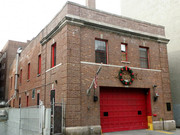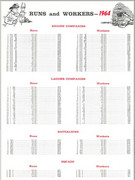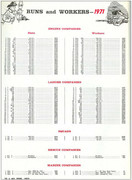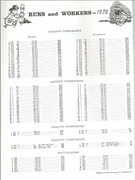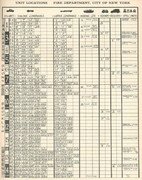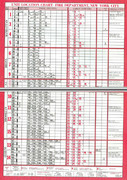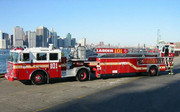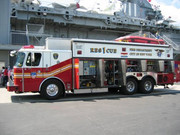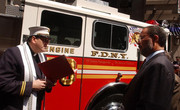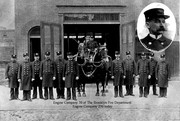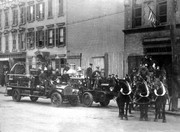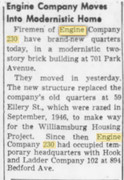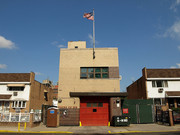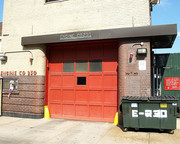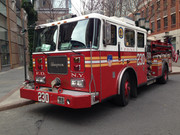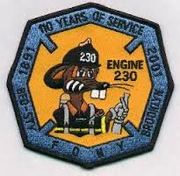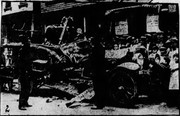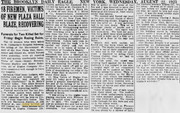FDNYTRUCKScom said:
Ferrara donated a couple of rigs, as did E-One, to both NYPD and FDNY. L163 got the rig that the People of Akron donated funds to. L14 got the South Carolina donation rig. E23's rig was paid for by Time Warner, one of the members in the company that was killed on 9.11, his wife worked for them. Airbus donated the funds for R1's E-1 rescue.
Ladder 163 Seagrave donated by Akron, Ohio:
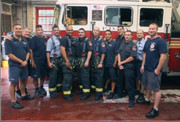
 http://www.ohio.com/news/dyer/akron-s-9-11-firetruck-flourishes-as-war-horse-and-symbol-1.234414?ot=akron.PhotoGalleryResponsive.ot&s=1.234413
http://www.ohio.com/news/dyer/akron-s-9-11-firetruck-flourishes-as-war-horse-and-symbol-1.234414?ot=akron.PhotoGalleryResponsive.ot&s=1.234413
Fallen Brothers Foundation website:
"Queens ladder company grateful to Akron for new fire truck N.Y. firehouse hit by tragedy twice this year
By David Giffels
NEW YORK: Ladder Company 163 and Engine Company 325 share an old brick firehouse with a big red garage door in the Woodside neighborhood of Queens. It's a gritty place built in 1939, bordered by two alleys and a fence topped with razor wire.
These days, it's decorated with a homespun display of candles and flowers and little notes of grief and affirmation, spread out on a card table on the sidewalk. Few companies were spared on Sept. 11, and Ladder 163 is no different. Two of its men died that day.
This is home to 50 members of New York's Fire Department, 11 of them working in any given shift. And it will soon be home to a brand-new ladder truck, a 45-foot-long rig that will fill half the truck bay.
When that truck arrives two weeks from now, it will bear a bronze plaque on the side: "A Gift from the People of Greater Akron, Ohio.''
The $850,000 rig is the centerpiece of the Fire Truck Fund -- the community effort that raised nearly $1.4 million in the weeks following the Sept. 11 terrorist attacks, and has also provided New York with two ambulances and three police cruisers.
Even in a city that has seen an unprecedented outpouring of good will, this gift stands out. The Fire Truck Fund is the largest single contribution to replace equipment after the attacks.
When ladder truck 163 comes home, it will be treated like a new baby, waxed and polished until it's so clean you could eat off its red bumpers. Snapshots will be taken. Neighbors will nod their approval. It will be the pride of the "Woodside Warriors.''
Day just beginning:
Go down the right alley, just past that shrine, to the heavy steel door with reinforced glass. Ring the buzzer. A sleepy-eyed firefighter answers. Coffee's on. Come on in.
Bob O'Neill shuffles by, wearing navy blue shorts, a blue FDNY shirt and an old pair of black work shoes, laced loosely so he can kick them off and jump into his fire boots if the alarm sounds. His tough Irish smile is framed by a thick mustache. He's rubbing his shaved head, still waking up.
It's 7:30 a.m. and the corners of the house are dark. There's growing activity in the kitchen and dining area, where shift Capt. Jim Donlevy is sitting down to coffee.
The table he leans on is a slab of an old bowling alley, some 15 feet long, decorated with the Woodside Warriors logo -- the profile of an American Indian. Painted in big letters on one end is "E 325, Pride of Woodside.'' Painted on the other is "L 163, We Rise to the Occasion.''
That same Warriors logo is on a bar-style neon sign hanging outside the dining room door.
Newspapers are spread out on the table; mismatched coffee cups steam here and there; cereal is being poured into bowls.
The conversation warms up on this early November morning -- inside jokes and locker-room insults; comments on the news and details of the coming day. The accents are thick, Queens and Brooklyn and Long Island. Many of these guys are Irish or Italian; perhaps half are second- or third-generation FDNY.
They are very much a type: aggressive, wisecracking and raw. The firehouse has the bare-knuckled charm and texture and -- oddly -- warmth of a rogue fraternity.
"These guys, they come in as individuals,'' Donlevy says. "But they get acclimated pretty quick.''
The Woodside Warriors serve an old Irish neighborhood that has become more mixed in recent years, with Hispanic residents moving into the modest houses and apartment buildings that form the bones of Woodside. Many of the candleholders on the shrine outside the building are decorated with images of "Divino Nino Jesus'' and "El Gran Poder.'' An old Asian lady has been stopping to water the mums.
Capt. Donlevy gets up from his coffee to give a nickel tour of the truck bay. Filling one side is 163's old rig, a 1989 model with a long ladder boom resting on top. "We Rise to the Occasion'' is painted on the boom that lifts a bucket nearly 100 feet into the air.
"It's a tired old thing,'' Donlevy says as he opens the door to one of the tool compartments, releasing a faint memory of smoke.
The old rig creaks when it takes corners. The suspension is shot. The boom isn't as tight as it once was, and the bucket can get rocking pretty good when the water pressure and wind kick in.
There's an old taxicab license plate screwed to the back and Indian feathers hanging in the cab. A New York Post sports page is tucked up on the dashboard.
The rig has had its share of breakdowns. A favorite story is the time the truck went out on a run and there was an electrical short. A call went out to dispatch:
"We have a warehouse on fire -- and Ladder 163 on fire.''
It was down for months after that, but returned. The truck was involved in the early stages of cleanup at the World Trade Center until it broke down and was pulled away for repair. Although most units that are replaced remain in service as spares, this one is likely to be retired permanently as soon as the Akron truck arrives.
As much as anything else, though, the biggest complaint is that it has no air conditioning. Because the men in the rear are sitting in tight quarters against the engine housing, it can get unbearably hot inside.
For all the adornments on the lumbering old rig, though, one stands out -- the gold-lettered plaque over the grille: "In memory of FF John Downing.''
A year of losses
Ladder 163, which hadn't lost a man since 1962, has suffered two heavy blows this year. When Sept. 11 hit, the company was still mourning the loss of Downing. He was killed in the "Father's Day fire,'' a June 17 warehouse blaze in the Astoria neighborhood of Queens, considered at the time one of the deadliest incidents in FDNY history. Three men died and two were badly injured.
Downing and O'Neill grew up in this Woodside neighborhood, Irish kids who ran the streets together. They both joined the Fire Department in 1989.
"He was a big hunk of a guy that liked to break chops,'' O'Neill says, sitting in the early sunlight on the bumper of 325's rig.
The morning of June 17, the two passed each other at shift change. O'Neill teased his friend. "Have a nice Father's Day. I'm goin' home. You?''
Within hours, Downing lay dead after part of the building collapsed.
"Father's Day, I cried like a little baby. I dreamt about him for weeks and weeks,'' O'Neill says. "These other two, it hasn't even hit me yet.''
Tributes to Downing's memory pepper the house. A green "Downing St.'' sign is suspended in a hallway near one of the two brass fire poles. His wooden coat hanger, bearing his name, is propped on the wall of the upstairs weight room. Photographs and newspaper clippings fill a dining room bulletin board.
And upstairs in the locker room, a threadbare yellow chair sits empty in a corner. On the windowsill behind it, a half-smoked cigar is resting on the bent-down rim of a coffee can. A handwritten note is taped to the chair:
"Please don't remove the cigar or place personal things on chair. They were John's, and this is where he spent many long hours studying. Thank you.''
Still haunted by Downing's memory, O'Neill has been to dozens of funerals, trying to process it all. Two months after Sept. 11, he was looking at an Internet site about the 343 lost firefighters and spotted the name of a guy he knew.
"I got a pain in the heart.'' He curses angrily. "I didn't even know he was dead.''
Donlevy says there's been no closure to the numbing losses at the World Trade Center.
"It's in the present,'' he says. "It's not in the past yet.''
The two members of Ladder 163 who died at the trade center -- Scott Larsen and Tom Gambino -- were serving with other companies on Sept. 11. Ladder 163 responded to the call that day, but got delayed at the tunnel into Manhattan.
"That 15 minutes saved everybody's lives,'' O'Neill says.
Gambino -- "Gambo'' -- was an 18-year veteran of the department and had 17 years with Ladder 163. He was in the midst of a transfer; on Sept. 10, he was assigned to a rescue company that got caught in the collapse. He left a wife and two sons.
Larsen, who was training with another company, died the day his wife was due to deliver their fourth child. His son, August, was born Sept. 13.
When the Akron truck arrives, it will bear a new plaque with the names of all three men.
The truck will represent a bond with a community in Northeast Ohio, once a foreign place to many of these native New Yorkers, but now the home of friends.
As O'Neill finishes the tale of Sept. 11, Scott Grubert passes through the truck bay, pulling out a cigarette. He nods hello.
"These guys are from Akron, Ohio. Their town is buyin' our new rig for us,'' Donlevy says.
"No kiddin'?'' Grubert says. He immediately offers a handshake. "Thanks.''
Donlevy opens an invitation to any visitor who may want to stop by and see the truck in its new home.
"We'll take care of 'em,'' he says, smiling. "We'll feed 'em a good lunch.''"
